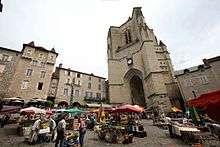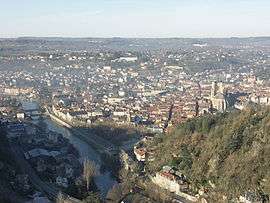Villefranche-de-Rouergue
| Villefranche-de-Rouergue | ||
|---|---|---|
|
An aerial view of Villefranche-de-Rouergue | ||
| ||
 Villefranche-de-Rouergue | ||
|
Location within Occitanie region  Villefranche-de-Rouergue | ||
| Coordinates: 44°21′12″N 2°02′06″E / 44.3533°N 2.035°ECoordinates: 44°21′12″N 2°02′06″E / 44.3533°N 2.035°E | ||
| Country | France | |
| Region | Occitanie | |
| Department | Aveyron | |
| Arrondissement | Villefranche-de-Rouergue | |
| Canton | Villefranche-de-Rouergue | |
| Intercommunality | Villefranchois | |
| Government | ||
| • Mayor (2008–2014) | Serge Roques | |
| Area1 | 45.85 km2 (17.70 sq mi) | |
| Population (2008)2 | 11,926 | |
| • Density | 260/km2 (670/sq mi) | |
| Time zone | CET (UTC+1) | |
| • Summer (DST) | CEST (UTC+2) | |
| INSEE/Postal code | 12300 / 12200 | |
| Elevation |
237–544 m (778–1,785 ft) (avg. 290 m or 950 ft) | |
|
1 French Land Register data, which excludes lakes, ponds, glaciers > 1 km² (0.386 sq mi or 247 acres) and river estuaries. 2 Population without double counting: residents of multiple communes (e.g., students and military personnel) only counted once. | ||
Villefranche-de-Rouergue (French: [vil.fʁɑ̃ʃ də ʁwɛʁɡ] ; Vilafranca in Occitan) is a commune in the Aveyron department in southern France.

History
At the end of the Albigensian Crusade from the northern "barons" against the southern Occitania on a religious pretext (fighting the Cathar heresy), the Count of Toulouse was defeated and concluded the treaty of Paris in 1229. By this treaty he gave the Rouergue county to his daughter who became the wife of Alphonse de Poitiers, brother of Saint Louis, king of France. Alphonse founded Villefranche on the place of an old village called La Peyrade in 1252.
During World War II, while occupied by Nazi Germany, Villefranche received a large 13th Waffen SS Handschar (1st Croatian) division. Led by Ferid Džanić, Eduard Matutinović, Božo Jelinek and Nikola Vukelić, one battalion staged a rebellion against the Nazis on 17 September 1943, (Villefranche-de-Rouergue uprising) but were soon suppressed and mostly executed on site. The few that escaped inspired the French resistance in Aveyron that had not been formed until then. After the war, an avenue in Villefranche was named Avenue des Croates (Avenue of the Croats) in honor of the uprising.
International relations
Twin towns — Sister cities
Villefranche-de-Rouergue is twinned with:
Population
| Historical population | ||
|---|---|---|
| Year | Pop. | ±% |
| 1793 | 8,497 | — |
| 1800 | 9,331 | +9.8% |
| 1806 | 9,283 | −0.5% |
| 1821 | 8,803 | −5.2% |
| 1831 | 9,540 | +8.4% |
| 1836 | 8,736 | −8.4% |
| 1841 | 9,088 | +4.0% |
| 1846 | 9,705 | +6.8% |
| 1851 | 9,613 | −0.9% |
| 1856 | 10,826 | +12.6% |
| 1861 | 10,172 | −6.0% |
| 1866 | 9,719 | −4.5% |
| 1872 | 9,312 | −4.2% |
| 1876 | 10,124 | +8.7% |
| 1881 | 10,366 | +2.4% |
| 1886 | 9,836 | −5.1% |
| 1891 | 9,734 | −1.0% |
| 1896 | 8,426 | −13.4% |
| 1901 | 9,730 | +15.5% |
| 1906 | 8,352 | −14.2% |
| 1911 | 8,439 | +1.0% |
| 1921 | 7,423 | −12.0% |
| 1926 | 7,825 | +5.4% |
| 1931 | 7,908 | +1.1% |
| 1936 | 8,479 | +7.2% |
| 1946 | 9,257 | +9.2% |
| 1954 | 8,676 | −6.3% |
| 1962 | 9,540 | +10.0% |
| 1968 | 10,709 | +12.3% |
| 1975 | 12,284 | +14.7% |
| 1982 | 12,693 | +3.3% |
| 1990 | 12,291 | −3.2% |
| 1999 | 11,919 | −3.0% |
| 2008 | 11,926 | +0.1% |
See also
References
- ↑ "Međunarodna suradnja Grada Pule". Grad Pula (in Croatian and Italian). Archived from the original on 2012-05-05. Retrieved 2013-07-28.
External links
| Wikimedia Commons has media related to Villefranche-de-Rouergue. |
- Tourist office website (in French)
- Pictures of Villefranche-de-Rouergue in "Paysages d'Aveyron"
- Walking in the streets of Villefranche Part I/Part II/Part III

.svg.png)